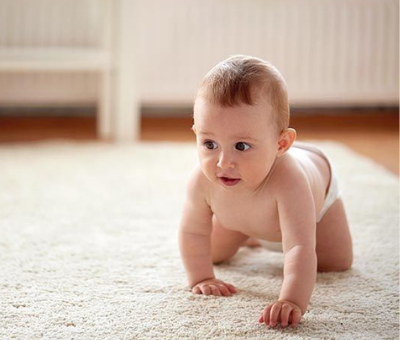
When Do Babies Roll Over?
Seeing your baby cross developmental milestones is always heart-warming. One such milestone is when your baby rolls over.
It’s one of the first signs of mobility and is equally surprising for your baby to discover that they can move like that.
Read through to see what to expect as a parent and how to help if they have not started rolling over yet!
Header image 📷 bounty.com
While practicing tummy time, babies gradually learn to roll over from their tummy to be on their back. This is one of their first signs of mobility as they can roll over completely on their own after they have developed head control. Initially, you may catch them rocking side to side during tummy time until they eventually have full strength to roll over.
When do babies start rolling over?
Some newborns start rolling over to their side during their sleep. On average, infants start rolling over between the end of their third month and 5th month. From practicing tummy time, they develop upper body strength to roll over. The quicker they develop their muscles, the quicker they can roll over. By the 6th month, infants can start rolling over not only from their tummy to their back but also from their back to their tummy.
How to help baby roll over
If you find that your child has not rolled over yet, here are some tips on how you can help them achieve their milestone.
1. Tummy time helps baby roll over
Tummy time is an integral part to set your baby up for rolling over. It helps build upper body muscles such as the neck, shoulder and back. Your infant can start tummy time as early as their first day. During their awake hours, start with a few minutes of tummy time each day, gradually building up to longer and more frequent sessions throughout the day as they get used to it. If you find that your infant is uncomfortable with tummy time, read some of our favourite tips on how you can make it more enjoyable for them here.
2. Environment
With babies, the right environment is very important for their development.
Playmat
The surface has to be suitable and comfortable enough for the baby to be encouraged to explore during tummy time. Rugs and carpets contain many harmful toxins that negatively affect the baby’s development in both the short and long term. Hardwood floors are too hard for their joints and bones, making them extra uncomfortable. While beds and mattresses may seem like the most comfortable option, it is too soft for your babies joints and bones. The ideal place to practice tummy time and eventually roll over would be a good baby mat.
ALZiP playmat is non-toxic and hypoallergenic, made of 9 layers of high-density foam designed to be placed in a unique egg-box shape, perfect for your baby’s development. It is made to be the right amount of firmness and softness.
Unique egg-box shape foam inside ALZiP mat
Perfect amount of firmness and cushioning
Customer review: 📷 Jedaiah with ALZiP Eco Color Folder Mat
Customer review: 📷 Jina with ALZiP Eco Color Folder Mat
Not only will a suitable playmat provide the right features for your baby’s development, but it will also provide a big space for your baby to move around and explore. As it is ideally placed on the ground, there is no hazard of rolling over onto the ground, compared to beds.
Toys
You can encourage your little one to roll over by placing toys around them. By positioning toys slightly out of reach, you can encourage them to move to reach the toys. This will encourage them to be more mobile and to try rolling over.
Additionally, you can encourage them to make the turn by wiggling their favourite toys in the other direction for them to follow.
Encouragement
You can provide physical encouragement for them to roll over. As they have never moved this way before, you can introduce it to them by gently rolling them over with your hands. Once they have realized it, they may learn to try on their own.
Clapping and applauding when they are moving side to side attempting to roll can be very encouraging for your little one. Excite them to try and roll over!
How to keep rolling baby safe?
Once your baby starts rolling over, they can be exposed to new hazards. Quickly, it is likely to become their new favourite trick and they’ll keep trying it often. It is important to keep an eye out, especially when they are on raised platforms like beds, changing tables and couches. As they are learning to be more mobile, it is a good idea to look into baby-proofing your house, if you have not yet.
Your baby may also be rolling over to their side during sleep. Remove any choking hazards from their sleep surrounding to make sure they are safe and free even if they roll over during their sleep.
What's next?
Gradually, your baby will work their way towards other milestones such as sitting up and crawling; keep an eye out for that!



